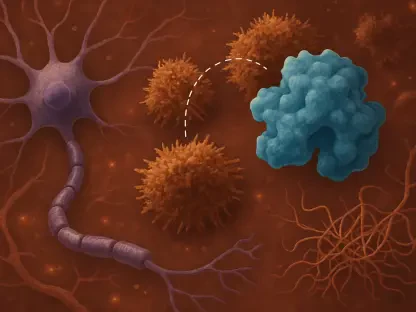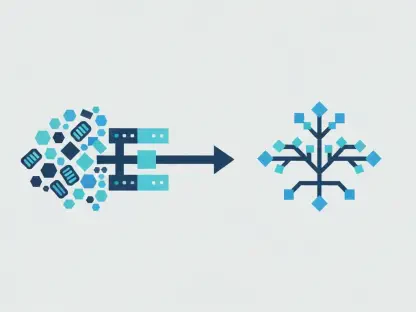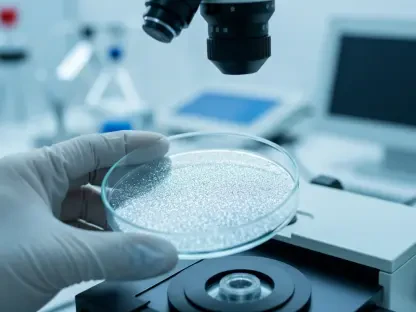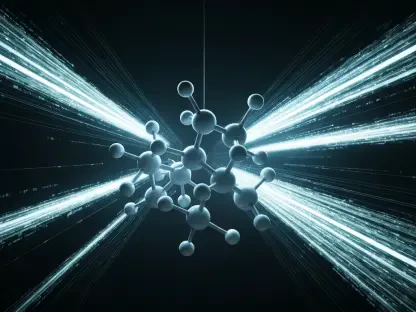Drug discovery has long been a daunting endeavor, with the staggering statistic that developing a single new drug can cost upwards of $1 billion and take over a decade to reach the market. Imagine a world where this timeline is slashed, costs are dramatically reduced, and even smaller research teams can contribute to life-saving innovations. This is no longer a distant dream but a tangible reality with the advent of a groundbreaking technology developed by researchers at the Karlsruhe Institute of Technology (KIT) in Germany. This guide unveils the transformative potential of the nanodroplet array platform, a tool poised to redefine early drug discovery by making it faster, cheaper, and more accessible. The purpose here is to equip researchers, biotech professionals, and academic institutions with an understanding of how this innovation works and why it matters in overcoming traditional barriers in the pharmaceutical field.
The significance of this guide lies in its ability to demystify a cutting-edge approach that addresses the core inefficiencies of drug development. By focusing on miniaturization and integration, the nanodroplet array platform offers a way to conduct high-throughput screening with minimal resources, a feat that was once exclusive to large pharmaceutical giants. Readers will learn the step-by-step mechanics of this technology and discover how it can democratize the process, enabling smaller entities to play a pivotal role in creating therapies for critical conditions like cancer. This exploration not only highlights a scientific breakthrough but also serves as a beacon for those seeking efficient solutions in a resource-intensive industry.
Unveiling a Revolutionary Approach to Drug Discovery
The nanodroplet array platform represents a paradigm shift in how early drug discovery is conducted, offering a solution to the time and cost burdens that have plagued the field for decades. Developed by a dedicated team at KIT, this technology utilizes droplets as small as 200 nanoliters to perform experiments on a scale previously unimaginable. Its potential to transform the identification of new therapeutic agents, particularly for complex diseases such as cancer, cannot be overstated, as it reduces the dependency on vast resources and extensive timelines.
Beyond its technical prowess, this platform stands out for its ability to open doors for academic institutions and smaller biotech firms. Historically, the financial and logistical demands of drug discovery have limited participation to well-funded corporations, but this innovation levels the playing field. By minimizing material needs and accelerating processes, it fosters an environment where diverse research entities can contribute to groundbreaking medical advancements.
The broader implications of this technology extend to the urgent need for accessible healthcare solutions worldwide. As a tool that enhances efficiency without compromising accuracy, the nanodroplet array could pave the way for faster development of treatments tailored to specific patient needs. This guide aims to illuminate how such a revolutionary approach can reshape the landscape of pharmaceutical research, inspiring a new era of collaboration and innovation.
The Urgent Need for Innovation in Drug Discovery
Traditional drug discovery is notorious for its lengthy timelines, often spanning over ten years from concept to market, creating a bottleneck in delivering critical treatments to patients. The financial burden is equally staggering, with costs frequently reaching hundreds of millions of dollars due to extensive clinical trials and iterative testing phases. Such constraints have long hindered progress, delaying the availability of therapies for life-threatening conditions.
These challenges have historically restricted participation to large pharmaceutical companies with the capital to sustain prolonged development cycles. Smaller organizations and academic researchers, despite their potential for innovative ideas, often lack the infrastructure and funding to compete in this space. This disparity underscores a critical gap in the industry, where novel solutions remain untapped due to systemic barriers.
The nanodroplet array platform emerges as a vital response to these pressing issues, offering a method that drastically cuts both time and expense. By enabling rapid synthesis and testing on a microscale, it addresses the inefficiencies that have slowed progress for decades. This section sets the stage for understanding why such an advancement is not just beneficial but essential for the future of drug development.
How the Nanodroplet Array Platform Works
Step 1: Miniaturization with Nanoliter Droplets
The first cornerstone of this platform is its use of nanoliter droplets, each as small as 200 nanoliters, roughly the volume of a grain of sand. This extreme reduction in scale allows experiments to be conducted with far less material than traditional methods, which typically operate on a microliter basis. Such miniaturization marks a significant departure from conventional practices, setting a new standard for resource efficiency.
Achieving Unprecedented Scale Reduction
This drastic downsizing translates to a 1,000-fold reduction in experimental scale, slashing the costs associated with reagents and other materials. Furthermore, each test requires only about 300 cells, a fraction of what older techniques demand. This efficiency not only conserves resources but also makes the technology viable for labs with limited access to extensive biological samples.
Step 2: Integrated Synthesis and Testing Workflow
The second step involves a seamless integration of synthesis, testing, and characterization on a single chip, an approach termed “direct-to-biology.” Unlike traditional workflows that require separate stages for each process, this platform consolidates them into one cohesive system. Such unification eliminates the need for time-consuming transfers and preparations between steps.
Streamlining Processes for Speed
By integrating these phases, the technology significantly reduces delays that often occur when moving from compound synthesis to biological evaluation. This streamlined process accelerates the identification of promising drug candidates, allowing researchers to focus on refining potential therapies rather than navigating logistical hurdles. The result is a faster path from concept to actionable results.
Step 3: High-Throughput Screening of Compounds
In the third step, the platform demonstrates its capacity for high-throughput screening, synthesizing and testing thousands of compounds in record time. A notable example is the synthesis of 325 MEK inhibitors for cancer treatment within just seven days, a task that would take months with conventional methods. This rapid turnaround redefines what is possible in early drug discovery.
Targeting MEK Enzymes for Cancer Therapies
Focusing on MEK inhibitors, which target enzymes linked to cancers like skin and colon cancer, the platform identified 46 compounds with efficacy comparable to mirdametinib, a recognized treatment for rare tumors. Testing on the HT-29 colon cancer cell line further validated these inhibitors’ potential by assessing cell viability. This targeted application showcases the technology’s precision in addressing specific therapeutic needs.
Step 4: Advanced Analysis with MALDI-MSI Technology
The final step employs matrix-assisted laser desorption/ionization-mass spectrometry imaging (MALDI-MSI) to provide detailed chemical characterization directly on the chip. This advanced analytical tool enables researchers to visualize and assess compounds without needing external equipment for each sample. It represents a leap forward in maintaining accuracy at a microscale.
Precision Insights through On-Chip Visualization
Collaboration with the Center for Mass Spectrometry and Optical Spectroscopy at TH Mannheim facilitated the analysis of 975 samples in triplicate, ensuring reliable and reproducible results. This on-chip visualization capability offers precise insights into compound behavior, enhancing the platform’s ability to deliver trustworthy data. Such precision is crucial for advancing candidates to further development stages.
Key Takeaways from the Nanodroplet Array Breakthrough
The nanodroplet array platform offers several transformative advantages that redefine early drug discovery. Miniaturization achieves a 1,000-fold reduction in experimental scale, conserving vital resources. Integration combines synthesis, screening, and analysis on a single chip, boosting efficiency. Speed is evident in the synthesis of hundreds of compounds in mere days rather than months. Accuracy remains uncompromised, as demonstrated by the successful identification of effective MEK inhibitors. Finally, accessibility lowers entry barriers, empowering smaller biotech firms and academic researchers to contribute meaningfully.
These benefits collectively address long-standing challenges in the pharmaceutical industry, providing a blueprint for more inclusive innovation. The platform’s ability to maintain reliability while operating at a reduced scale ensures that scientific rigor is not sacrificed for efficiency. This balance is essential for gaining trust and adoption across diverse research environments.
Broader Impacts and Future Potential of Nanodroplet Technology
The nanodroplet array platform aligns with a growing trend toward miniaturization and efficiency in drug discovery, signaling a shift in how the industry approaches early-stage research. Its impact extends beyond cancer therapies, with potential applications in other therapeutic areas such as infectious diseases and neurological disorders. This versatility positions the technology as a cornerstone for addressing a wide range of medical challenges.
Scaling this innovation for widespread adoption remains a key consideration, as integrating it into existing workflows may require adjustments in infrastructure and training. However, the long-term benefits of reduced costs and accelerated timelines outweigh these initial hurdles. Continuous refinement and adaptation could further enhance its compatibility with various research settings over the coming years.
Looking ahead, this technology has the potential to foster unprecedented collaboration between academic, industrial, and clinical spheres. By lowering financial and logistical barriers, it encourages diverse teams to pool expertise and resources, driving innovation at an accelerated pace. The future of drug discovery could see a more interconnected and responsive network, ultimately benefiting patients through quicker access to novel treatments.
Embracing a New Era in Drug Discovery
Reflecting on the journey through this guide, the steps taken to understand the nanodroplet array platform reveal a transformative path that tackles age-old inefficiencies in drug discovery. The meticulous process of miniaturization, integration, high-throughput screening, and advanced analysis demonstrates a remarkable synergy that redefines speed and resource use. Each phase builds upon the last, culminating in a proven method that identified potent MEK inhibitors in a fraction of the usual timeframe.
As a next step, stakeholders in the biotech and pharmaceutical sectors are encouraged to explore partnerships and pilot programs that integrate this technology into their workflows. Investing in training and equipment to support nanodroplet arrays could position organizations at the forefront of innovation. Additionally, advocating for funding and policy support to expand access to such tools is crucial for smaller entities.
Beyond immediate adoption, the focus shifts to envisioning how this platform could evolve to address emerging health crises over time. Researchers and industry leaders are prompted to consider collaborative research initiatives that leverage this technology for uncharted therapeutic areas. By sustaining momentum and curiosity around such advancements, the collective effort can ensure that life-saving treatments reach patients with unprecedented speed and efficiency.









